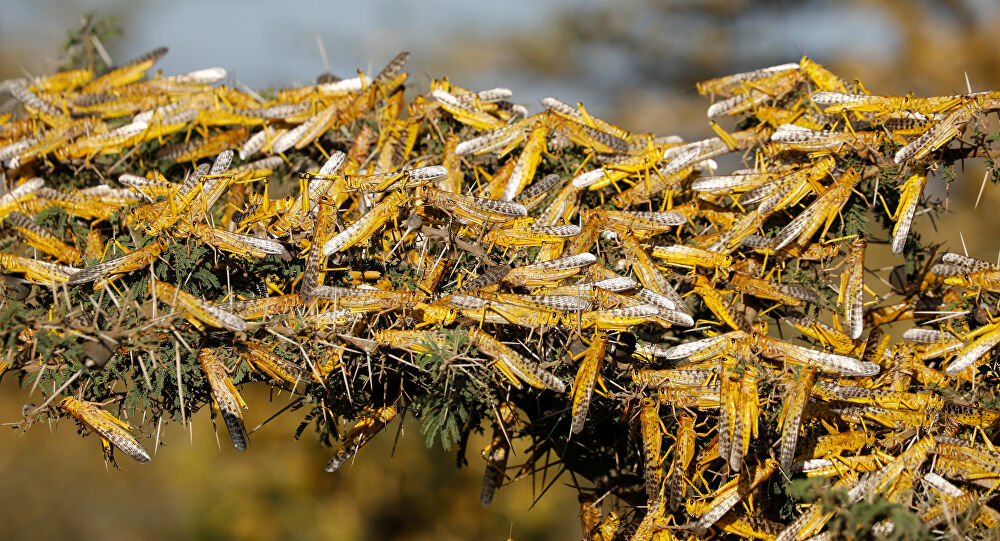Swarms of desert locusts that have invaded the country since mid-February have caused no damage to farms and orchards so far, thanks to the effective battle carried out by the Plant Protection Organization affiliated with the Agriculture Ministry, according to the spokesperson of PPO.
“New bands of the desert locust will be entering the country within the next few days from the littoral states of the Persian Gulf, namely Saudi Arabia, Oman and the UAE. All the efforts of PPO are focused on preventing the pest from devastating agricultural production in the seven infected provinces,” Mohammad Reza Mir was also quoted as saying by Young Journalists Club.
According to the official, the locusts have been fought on 195,155 hectares in the southern provinces of Sistan-Baluchestan, Hormozgan, Bushehr, Fars, Kerman, Khuzestan and South Khorasan.
“Out of the seven aforementioned provinces, Sistan-Baluchestan is the worst hit where the pest has been confronted on more than 75,295 hectares,” he said.
The PPO spokesman said that out of the 650 billion rials ($3.94 million) allocated by the government to the battle against desert locusts, some 350 billion rials ($2.12 million) have been received.
PPO has requested a total of 850 billion rials ($5.15 million) for a thorough, effective battle.
“The migratory pest has found its way to Iran from the littoral countries of Persian Gulf where due to barren lands and the fact that very little or no agricultural activity takes place, no serious battle against it has taken place. However, due to Iran’s effective measures against the spread of the locust, fewer swarms have invaded India, Pakistan and Iraq,” he said.
“We are planning to use drones to battle the voracious pest in mountainous and inaccessible areas such as swamps. Yet the most effective and environment-friendly method is to use vehicle-mounted and handheld sprayers.”
Mir noted that until now, no amount of the $500,000 Emergency Technical Cooperation Program (TCP) agreement signed with the Food and Agriculture Organization of the United Nations on March 19 has come through.
“We are in talks on how the procedures should take place,” he said.
The TCP project aims to enhance the country’s technical capacity for early warning, monitoring and management of the desert locust.
Funded by FAO, the project will contribute to the efforts of the Iranian national and local managers and experts in five southern provinces of Khuzestan, Bushehr, Fars, Hormozgan and Sistan-Baluchestan by providing knowledge, skills and equipment to detect, track and rapidly respond to desert locust infestation, FAO writes on its website.
As per the agreement and in close collaboration with PPO, FAO will initially conduct a workshop for three Iranian experts on training skills.
Afterwards, the organization will organize a number of training workshops for 320 locust, plant protection and agriculture officers in the concerned provinces, enabling them to effectively utilize and maintain Ultra Low Volume sprayers and to further empower them in survey and control operations and in reporting on desert locusts.
In consultation with the FAO Desert Locust Information Service, a locally modified offline mobile application will be developed to facilitate the recording and collection of information (text, graphics, photos and videos) on desert locust biology, behavior, survey, reporting, control and safety.
The first generation of desert locusts attacked Iran about a year ago. FAO alerted Iran of probable locust attacks on Jan. 21, IRNA reported.
The Plant Protection Organization of Iran battled the pest across 750,000 hectares in the previous round of attack that cost PPO more than $2.74 million. The figure is expected to exceed 1 million hectares this year, hence the need for more budget.
Mohammad Reza Dargahi, the head of PPO, has said that the battle this year is three times as intense as last year.
FAO believes this round of desert locust outbreak to be the worst in 25 years across East Africa and Southwest Asia.


